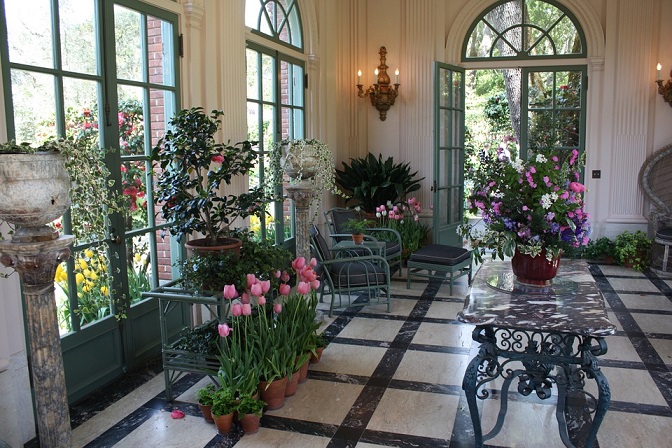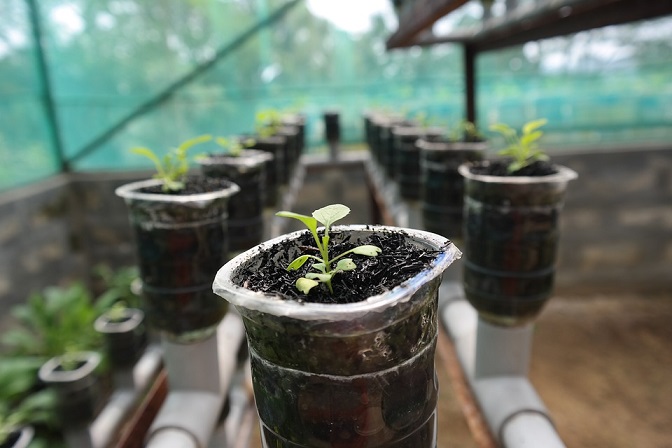7 Tips to Starting Your Own Indoor Garden
If you hate paying loads of your hard-earned money for overpriced and not so fresh veggies and fruits from the store, you can easily start up your very own indoor garden and grow them yourself.
This is possible even if you don’t have a backyard or if you live in a small apartment or house.
All you need to do is provide your home edible plants with the essential elements they will need to grow to thrive and yield produce, and you will be enjoying the fruits of your labor pretty soon!

Here are the basic guidelines for setting up an indoor garden:
1. Find the best space for your plants
You can set up your indoor garden even in the tightest spaces, such as on the window sills or on a table. If you have more space you can dedicate a bench or two for your plants. In tighter spaces, a shelf will be perfect for placing your pots and containers, but always make sure that the light reaches all of the plants on all shelves.
You can opt for a grow tent which can be placed in a darker or cooler area of the home such as the garage or basement as well. The grow tent will allow for complete control of the temperature, humidity and lighting the plants receive at all times.
When picking the spot for your indoor garden, choose one which has natural sunlight and is not draughty. The temperature in the room must be suitable for growing plants, and so must be the humidity.
2. Ensure that your home garden has enough light
The best case scenario is placing your plants in a spot in your home where they can get 12-14 hours of direct sunlight. This, of course, is not always possible, especially in the winter when the days are shorter. This is why you should consider opting for grow lights. You can combine the artificial with the natural lighting for an even better effect.
Light is an essential element for the photosynthesis which allows the plants to live and grow. If the light is insufficient, your plants will grow weak, spindly and tall, their leaves may not develop fully, and chances are that you will see no fruits or flowers at all.

A grow light which is specially designed for plants has special bulbs which emit light at the same wavelength as sunlight, and which can be absorbed by the photoreceptors of the plants. A regular lamp will not work, so consider purchasing a good quality grow light for your indoor garden.
Your grow light must be placed as close as possible to the leaves of the plants but without burning them.
Most edible plants require about 14 to 16 hours of sunlight or artificial light in order to grow strong, flower and yield produce. Some plants require even more light – from 16 to 18 hours, and other short day plants will need only about 10 to 13 hours of light.
You can tell that a plant is not getting enough light if its leaves or stem are small and thin. If the plant is getting too much light it will not bloom as the light will destroy its florigenic hormone.
You should choose the size of your grow light in accordance with the number of plants you have, the area you want to be covered, and the amount of sunlight which the plants are already getting.
Remember to stop the lights at night, so that the plants can rest, just like you.
3. Adjust the temperature and humidity levels
A temperature of 65 to 75 degrees Fahrenheit is appropriate for most indoor edible plants. Even if the temperature happens to vary to up to 10 degrees, your plants will be alright. If the temperature is too high, the plants will be small and weak, and if the temperature is too cold, the leaves will turn yellow and can fall off.
You can get a thermostat which controls the temperature, and keeps it from dropping or rising abruptly.
As for the humidity, sometimes the heating indoors causes the air to be drier. When the humidity in the room is low, your plants can start losing leaves, they will look withered and puckered, their leaves can start turning brown.
You can help increase the humidity around your indoor garden by misting your plants on a daily basis or even more often when needed. You can also help increase the humidity by placing a tray of water near the garden and add some lava rocks in it to help increase the surface for evaporation of the water.
You can also place the plants closer together so that they create their own microclimate and keep the humidity levels higher.
If the air in your home is really dry, you may want to consider getting a humidifier, which will not only benefit your plants but will help you breathe better and will moisturize your skin too.
4. Choose the appropriate growing medium
Choosing the right medium to grow your plants is another key factor for your success.

Soil
If you decide to use traditional soil, opt for mixes which are made for indoor gardening. Avoid using soil from outdoors, because it is usually heavier, and can have weed seeds and insects in it.
Instead, opt for an organic soil mix with some coconut hair, bark or compost in it. These elements will help make the soil richer and better aerated.
You can even create your own mix at home using one or more of the elements from above.
Hydroponics
Soil-less gardening is very popular for indoor gardening. Instead of using soil to hold the roots and the nutrients for your indoor plants, you can opt for hydroponics, where you will be providing the nutrients to the plants directly.
Hydroponics has a number of advantages worth mentioning including:

- A 50% faster-growing rate of the plants thanks to the ready access to nutrients and water
- Smaller containers which will take up less space because the roots will not need to anchor themselves
- The risk of the plants getting infected by pests or disease is lower, as they are started in a disease-free environment
- In case a plant gets sick, with hydroponics the disease is usually contained in a single plant rather than affecting the entire indoor garden
- The plants will droop when they need water, so you will know exactly when to add water and prevent damage to them
- Choosing the right plants for your indoor garden
- You can grow nearly any edible plant indoors, as long as it doesn’t grow too large to be contained inside.
- Always pick plants which have similar requirements for temperature, humidity, and light for your home garden.
- Just about any edible plant can be grown in a container.
5. Some of the most popular choices for plants for your indoor garden include:

- Vegetables, such as salad greens, peppers, kale, carrots, tomatoes, chard, beans or radishes
- Herbs, such as basil, rosemary, mint, parsley, cilantro, oregano, chives or lavender
- Fruits, such as dwarf apples, lemons, strawberries, blueberries or avocado
You can start your plants from seeds or seedlings. Using seeds is the less expensive option, as they are sold in large quantities and are much more affordable and one package will include seeds sufficient for planting for years to come.
6. Watering your indoor plants
Plants in pots or containers will dry out faster than those grown in outdoor gardens, so they need to be watered more often.
Always use water which is at room temperature for watering your home plants. You can leave your water can full of water near the plants to ensure that its temperature is just right when it comes time for watering them.
Make sure that you pour enough water in the pot or container so that it starts seeping out of the drainage holes on the bottom. This will mean that the water has passed through the roots and the nutrients have reached them.
Pour out the excess water from the saucer underneath the pots to avoid rotting and molding.
Over-watering the plants is as harmful as under-watering them, so always check how the soil feels before proceeding with the actual watering. When you put your finger in the soil, it should feel nice and damp rather than soggy. If it is soggy, leave the watering for the next day or for later. If the soil is completely dry proceed with the watering immediately.

There are some tell-tale signs that your plants may be getting to little or too much water.
If you are over-watering your indoor garden, the lower leaves of the plants can start dropping, there can be a discoloration of the leaves, as well as wilting from the stem and of the foliage.
If your plants are not getting enough water, the soil will be dry, the leaves will start developing brown edges, the flowers and leaves will start dropping and there can be wilting along the outer tips of the leaves.
7. Fertilize your plants
Since the soil in the pots or containers includes a limited amount of nutrients which are essential for your plants, they will be taken up by the plants pretty quickly. This is why you need to add nutrients to the soil periodically.
Read the instructions on the fertilizer of your choice to see how often and how much to add.
You can even make your own organic fertilizer for your indoor garden by:
- Mixing finished compost with
- Three parts of water and letting it sit for several hours
- After that you can strain the mixture into a watering can or other container and throw the leftover compost back into the compost bin or outdoors in the garden.
The liquid needs to be diluted with water until it starts looking like weak tea, and then it can be applied to the soil of your indoor plants.
Final words
Yes, growing your own edible plants indoors does require some effort, patience, and some money, but in the long run, the joy of being able to eat your own home-grown food will pay off for all of your hard labor.
Every home can have its own indoor garden no matter how much space you have available, and no matter the lighting, as long as you follow these basic guidelines for setting up and caring for your home plants.
Once you get the hang of it, your daily gardening will become one of your preferred chores or hobbies, especially as you watch your plants grow large and strong and start blooming and reproducing, so it is absolutely worth it.
Plus, you will save a lot of money for buying expensive fruits, vegetables or herbs with unknown origin and can feed yourself and your family with fresh and organic produce instead.


This is excellent – too often people say they can’t grow any veg as they don’t have a garden but this show how they can! If everyone who buys sprouted seeds for example grew their own just think how much packaging would be eliminated. #GoingGreen
Hi Rosie,
Thank you. I am glad you found my article information and I do agree that if people started their own seeds it would eliminate so much waster. Thank you for hosting Going Green Linky and stopping by to comment.
I didn’t know you could make fertilizer by soaking and straining compost, I’ll have to try that!
HI Kaylee,
Yes strained compost is an excellent fertilizer. I have used it. Thanks for stopping by, reading my article, and commenting. Have a healthy, happy & blessed day.